Picture this: you wake up, groggy, craving that perfect cup of coffee to kickstart your day. The Tchibo Single Serve Coffee Maker is your new best friend. It’s a sleek, compact machine that grinds and brews fresh coffee with one touch, delivering café-quality espresso or coffee without the waste of pods.
For just $399, it’s a steal for anyone who loves convenience, sustainability, and a damn good brew. Trust me, this German-engineered gem will transform your mornings. Ready to elevate your coffee game?
Let’s explore why I’m obsessed with this machine.
My Journey With The Tchibo Coffee Machine
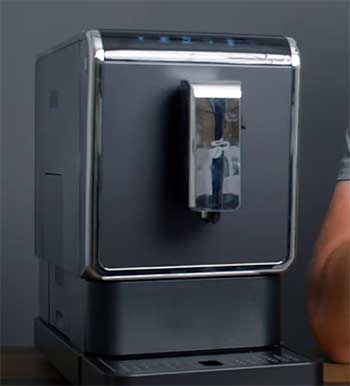
I’ll be honest—before the Tchibo Single Serve Coffee Maker landed on my counter, I was a pod-machine skeptic.
I’d been burned by Nespresso’s wasteful capsules and Keurig’s lackluster brews.
So, when I unboxed the Tchibo, I was cautiously excited.
The setup was a breeze: unpack, rinse the water tank, load the bean hopper, and fill the reservoir.
Within minutes, I was ready to brew.
The machine came with three bags of Tchibo’s Röstfrisch beans—light, medium, and dark roast—which was a nice touch, though I started with my favorite Kona blend.
My first brew was a 2 oz espresso. I pressed the button, and the machine whirred to life, grinding the beans with a satisfying crunch. The aroma hit me first—rich, nutty, and warm. When the espresso poured out, it had a gorgeous crema, not as thick as a barista’s pull, but impressive for a home machine.
The taste?
Bold yet smooth, with none of the bitterness I’d gotten from pod machines. I tried the 6 oz and 8 oz settings next, and both delivered hot, flavorful coffee that rivaled my local café. The “Intense” button became my go-to for that extra kick when I needed it.
What struck me was the simplicity. The LED touchscreen is intuitive—think smartphone ease. I could customize the brew size by holding the button, and the machine remembered my preference. The adjustable spout fit everything from my tiny espresso cups to my oversized travel mug.
Over the next month, I used it daily, sometimes twice, and it never faltered. The bean hopper kept my coffee fresh, and the grounds tray was easy to empty. Sure, the water tank needed frequent refills, but that’s a small price for such fresh coffee.
This machine felt like having a barista in my kitchen, minus the small talk.
Pros of The Tchibo Coffee Machine
- Effortless One-Touch Brewing
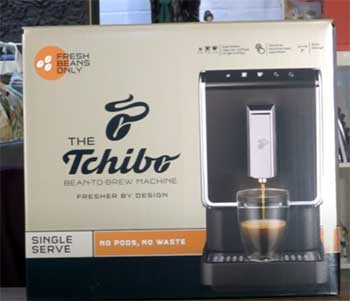
You know those mornings when you can barely function?
The Tchibo’s got your back.
Its touchscreen panel lights up with clear icons: espresso, small coffee, large coffee, and an “Intense” option.
Press a button, and in under three minutes, you’ve got a steaming cup. .
No fiddling with settings or guessing—it’s foolproof. I’ve brewed perfect cups even half-asleep, and that’s saying something.
- Freshly Ground Coffee Every Time
The built-in stainless steel burr grinder is a game-changer. Unlike pod machines that use stale grounds, the Tchibo grinds your beans fresh for each cup.
You can tweak the grind size (five settings!) to suit your taste. I love a fine grind for a bold espresso, and the machine nails it. The aroma alone is worth the price—your kitchen will smell like a European café.
- Eco-Friendly and Cost-Effective
Say goodbye to plastic pods piling up in your trash. The Tchibo uses whole beans, cutting waste and saving you money. I calculated that after 90 days, I’d saved nearly half the machine’s cost by ditching Nespresso capsules.
Plus, you can use any non-oily beans—Peet’s, local roasts, or Tchibo’s blends. It’s a win for your wallet and the planet.
- Compact and Stylish Design
At 7” wide, 12.4” tall, and 15.6” deep, this machine fits anywhere. My tiny apartment kitchen has zero counter space, yet the Tchibo tucks neatly under my cabinets. Its matte black finish with chrome-like trim looks sleek, not clunky.
It’s sturdy too—16.5 pounds of German engineering that feels built to last.
- Customizable Brews
You’re not stuck with rigid settings. The Tchibo lets you adjust brew sizes (2, 6, or 8 oz) and even tweak the volume by holding the button during brewing. Want a stronger cup? Hit the “Intense” button.
It’s like having a barista who knows your exact preferences. My partner likes a lighter brew, and I prefer it bold—we both get what we want.
- Easy to Clean
Cleaning is a breeze. The drip tray pops off with a magnetic snap, and the grounds container holds about 10 brews before needing a dump. The brewing unit slides out from the side for a quick rinse under warm water.
I do this weekly, and it takes maybe five minutes. The automatic descaling program is a lifesaver—just add the solution, press a button, and it does the rest.
Not-So-Good Parts of The Tchibo Coffee Machine
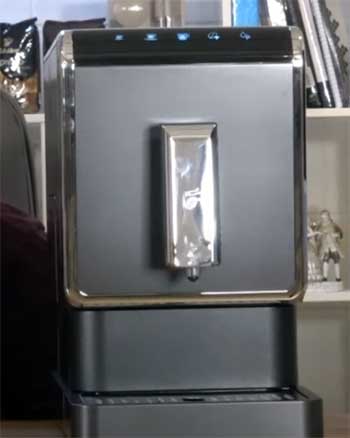
- Small Water Tank: The 37.2 oz water tank is my biggest gripe. If you’re brewing multiple 8 oz coffees, you’ll refill it often—sometimes daily if you’re a heavy drinker like me. It’s not a dealbreaker, but it’s annoying, especially since the tank’s at the back. If your machine is under cabinets, you’ll need to slide it out to refill, which can feel like a chore.
- Noisy Operation: This machine isn’t whisper-quiet. The grinder makes a noticeable crunch, and the brewing unit whirs as it works. I don’t mind the sound—it’s kind of satisfying—but if you’ve got a sleeping partner or baby nearby, it might wake them. It’s not as loud as a blender, but don’t expect library-level silence.
- No Milk Frother: If you love lattes or cappuccinos, you’ll need a separate frother. The Tchibo focuses on espresso and coffee, with no built-in milk steaming option. I’ve worked around this by heating milk in the microwave, but it’s an extra step. For the price, I wish they’d included a steam wand, even a basic one.
- Grind Adjustment Limitation: You can only adjust the grind size while the grinder is running, which is a bit awkward. If your household has different grind preferences, you’ll need to plan ahead. I set mine to the finest setting and left it, but my partner found it tricky when he wanted a coarser grind for his morning brew.
- Cabinet Clearance Issues: The water tank’s top-loading design means you need clearance above the machine to refill it. If it’s under low cabinets, you’ll have to pull it out each time. I solved this by placing it on a sliding trivet, but it’s an extra step. At 16.5 pounds, it’s not heavy, but it’s not featherlight either.
Maintenance Tips For Your Tchibo Coffee Machine
- Regular Cleaning Routine: Keep your Tchibo happy with a quick daily cleanup. Empty the drip tray and grounds container when the warning light flashes (usually after 10 brews). Wipe the exterior with a damp cloth to catch any spills. Once a week, pop out the brewing unit from the side and rinse it with warm water—no soap needed. This keeps the coffee tasting fresh and prevents clogs.
- Descaling Done Right: Descaling is crucial to avoid buildup, especially if you have hard water. The machine’s descaling light will nudge you every few months. Use a proper espresso machine descaler (I like Durgol) instead of vinegar—it’s gentler on the internals. Fill the tank with the solution, run the descaling cycle, then flush with clean water. It’s a 10-minute process that keeps your machine running smoothly.
- Bean Hopper Care: Only fill the bean hopper with what you’ll use in a day or two to keep beans fresh. The aroma-sealing lid helps, but stale beans can dull your coffee’s flavor. Avoid oily or flavored beans—they can gum up the grinder. I stick to Tchibo’s blends or Peet’s Major Dickason’s, which work perfectly. If you switch beans, run a cleaning cycle to avoid flavor crossover.
- Water Tank Maintenance: Always use filtered water in the tank to reduce scale buildup. The built-in filter helps, but it’s not foolproof. Empty and rinse the tank weekly to prevent mold or stale water smells. If you’re not using the machine for a few days, empty the tank completely and let it dry to avoid any funky buildup.
- Grinder Maintenance: The stainless steel burr grinder is low-maintenance, but don’t mess with it unnecessarily. Adjust the grind only during operation to avoid jamming. If the grinder sounds strained, check for compacted grounds in the chute. I use a toothpick to gently clear it, but be careful not to force anything. A clean grinder means better-tasting coffee.
- Store It Smart: If you’re not using the machine for a while, empty the water tank, grounds tray, and bean hopper. Store it in a dry place to prevent mold or damage. I learned this the hard way after leaving grounds in for a weekend—let’s just say the smell wasn’t inviting. A quick wipe-down before storing keeps it pristine.
Comparison of Tchibo Coffee Machine With Other Brands
Let’s put the Tchibo Single Serve Coffee Maker head-to-head with some heavy hitters: the Café Bellissimo Espresso Machine, De’Longhi Magnifica Plus Espresso Machine, and Philips 5400 Espresso Machine. I’ve used or researched these machines extensively, so I’m breaking down how they stack up against my beloved Tchibo. Picture us chatting over a fresh brew as I walk you through the differences.
- Tchibo Vs. Café Bellissimo Espresso Machine

The Café Bellissimo, priced around $479, is a stylish contender with a modern vibe that rivals Tchibo’s sleek look.
Both machines are compact, but the Tchibo (7” wide, 12.4” tall) edges out slightly for smaller kitchens compared to the Bellissimo’s bulkier 12.8” height.
The Tchibo’s bean-to-cup system grinds fresh for every brew, delivering rich espresso with solid crema.
The Bellissimo also grinds fresh, but its 15-bar pump can produce slightly thicker crema, which is a win for espresso purists. However, the Bellissimo lacks the Tchibo’s “Intense” button for customizing strength on the fly.
Cleaning is where Tchibo shines. Its magnetic drip tray and side-access brew unit make maintenance a five-minute task. The Bellissimo’s cleaning process is more involved, requiring you to disassemble parts for a thorough rinse. One downside for both: neither has a milk frother, so latte lovers need an external device.
The Bellissimo uses a touchpad interface, but I find Tchibo’s LED touchscreen more intuitive, especially when I’m half-awake. Price-wise, Tchibo’s $399 is a better deal, especially since it includes three bags of beans. The Bellissimo feels premium, but Tchibo gives you more bang for your buck if you prioritize simplicity and eco-friendliness.
- Tchibo Vs. De’Longhi Magnifica Plus Espresso Machine
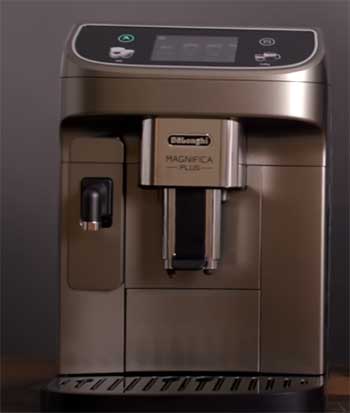
The De’Longhi Magnifica Plus, retailing at about $999, is a beast for coffee enthusiasts who want it all.
Unlike the Tchibo, it boasts a built-in milk frother, letting you whip up cappuccinos without extra gear.
I’ll admit, I was jealous of that feature—my Tchibo requires a separate frother for my occasional latte cravings.
Both machines grind beans fresh, but the Magnifica Plus offers 13 grind settings compared to Tchibo’s five, giving you more control over flavor.
That said, I rarely tweak my Tchibo’s grind, so the difference feels academic for casual users like me.
The Magnifica Plus is bulkier (11.2” wide, 14.2” tall), eating up more counter space than the Tchibo’s compact frame. It’s also quieter—its grinder hums softly, while Tchibo’s crunch might wake a light sleeper.
De’Longhi’s touchscreen is colorful and fancy, but I found Tchibo’s simpler LED panel easier to navigate in a rush. Cleaning both is straightforward, though Tchibo’s magnetic tray and auto-descaling edge out the Magnifica’s slightly fussier process.
For nearly $600 more, the De’Longhi delivers latte versatility, but Tchibo matches its coffee quality for straight espresso or coffee at a fraction of the cost.
- Tchibo Vs. Philips 5400 Espresso Machine
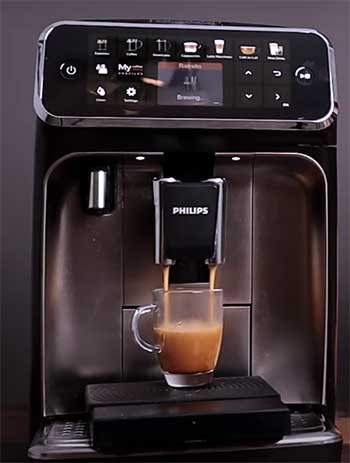
The Philips 5400, priced around $849, is a high-tech marvel with a focus on automation.
Like the Tchibo, it’s a bean-to-cup machine, but it offers 12 drink options, including lattes and cappuccinos, thanks to its integrated milk carafe.
If you’re a milk-based drink fan, the Philips is tempting—I sometimes wish my Tchibo could froth milk on its own.
Both machines produce excellent espresso with decent crema, though Philips’ 15-bar pump slightly outperforms Tchibo’s 10-bar for intensity.
The Tchibo’s “Intense” button helps close the gap, letting me boost flavor without extra steps.
The Philips is chunkier (9.7” wide, 14.6” tall) and feels less suited for tiny kitchens than the Tchibo. Its touchscreen is sleek but can be overwhelming with so many options; Tchibo’s minimalist controls are more my speed.
Cleaning is a toss-up: Philips’ milk system needs extra care, while Tchibo’s grounds tray and brew unit are a breeze to rinse. The Philips also supports ground coffee, unlike Tchibo, which is strictly whole beans. However, at $399, Tchibo’s eco-friendly, pod-free design and included beans make it a better value for those who don’t need milk-based drinks.
Why Tchibo Stands Out?
Across these matchups, the Tchibo holds its own. It’s not the flashiest—it lacks a milk frother and has a smaller water tank (37.2 oz vs. Philips’ 60 oz or De’Longhi’s 64 oz)—but its compact size, ease of use, and wallet-friendly price make it ideal for most homes.
The Café Bellissimo is close in simplicity, but Tchibo’s lower cost and included beans tip the scale. De’Longhi and Philips cater to latte lovers with pricier, feature-heavy designs, but if espresso or black coffee is your jam, Tchibo delivers café-quality results without breaking the bank. Its eco-conscious, pod-free brewing seals the deal for me.
Frequently Asked Questions (FAQs)
The Tchibo coffee maker is designed in Germany, but there’s some debate about its manufacturing. Some sources suggest it’s a white-label version of a Severin machine, likely produced in China, though Tchibo doesn’t confirm this. The German engineering shines through in its build and performance, regardless of where it’s assembled.
Tchibo’s coffee beans come from top regions like Brazil, Ethiopia, India, and Colombia. The brand, rooted in Germany, roasts its beans there, ensuring quality. Their Röstfrisch line, included with the machine, is crafted with European coffee culture in mind.
There’s no definitive record of Kim Kardashian using a Tchibo machine. She’s been spotted with high-end brands like Miele or Jura in her home, often showcased on social media. These are pricier, feature-heavy machines, but the Tchibo could easily fit her aesthetic for a more budget-conscious choice.
No, the Tchibo only takes whole beans. Its built-in grinder is designed for fresh grinding, so ground coffee isn’t an option. This ensures maximum flavor but limits flexibility if you prefer pre-ground blends.
Why The Tchibo Coffee Machine Is A Must-Have?
After months with the Tchibo, I’m hooked. It’s transformed my mornings with fresh, café-quality coffee at the push of a button. Its eco-friendly design, compact size, and customizable brews make it a standout.
Sure, it’s not perfect—refilling the water tank can be a hassle—but the pros far outweigh the cons. For $399, you’re getting German-engineered excellence that rivals pricier brands. If you want barista-level coffee without the waste or complexity, grab a Tchibo.
Your kitchen (and your taste buds) will thank you.
